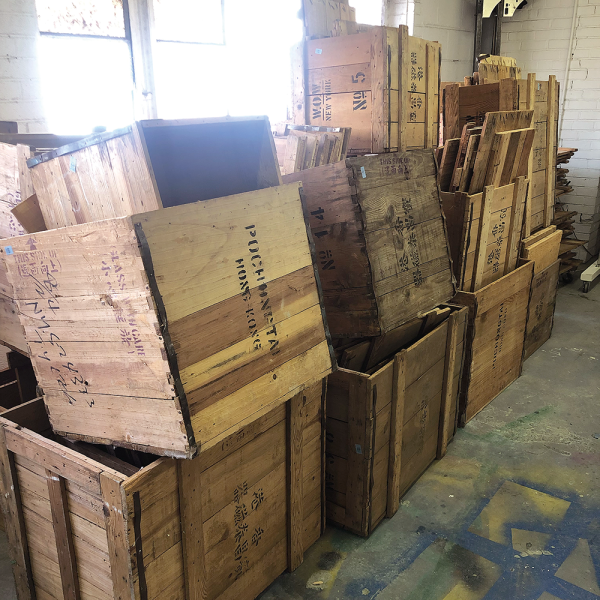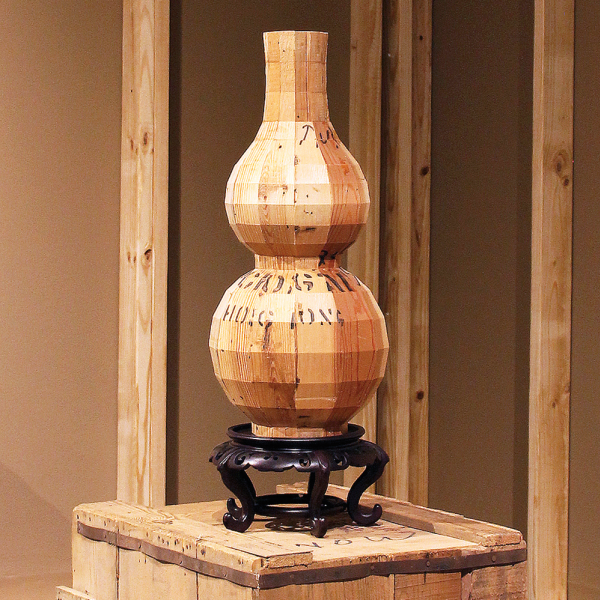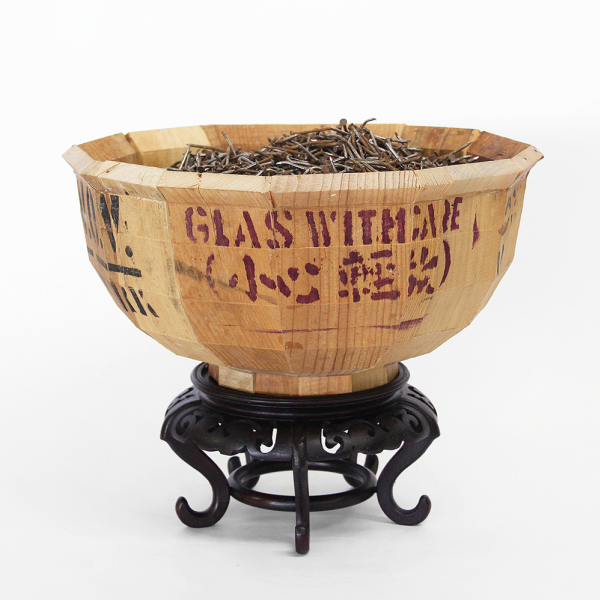Containing Memories
Containing Memories
The cargo arrived in January 2023: a truckful of hardwood panels, driven from Manhattan’s Chinatown to Richmond, Virginia, where Vivian Chiu received them at her studio. Stenciled on their weathered surfaces were numbers and a shipping company’s name, in Chinese characters—marks of their past lives as crates that ferried Chinese porcelain and other wares across the Pacific to America. In Richmond, they were raw material for Chiu, an artist and woodworker, who sized up her challenge ahead. “None of it was straight or flat; the wood was warped; it had different thicknesses,” she says. “It carried the mark of human hands.”
By that summer, Chiu had transformed several panels into sculptures through her own labor-intensive process. The wood is no longer rough-edged but streamlined, contoured into elegant replicas of traditional Chinese vases, from pear-shaped vessels to a bulbous double-gourd piece. They are tributes to not only the crates’ former contents but also the business that for decades received those shipments, before finally gifting the crates to Chiu: Wing on Wo & Co., the oldest store in New York City’s Chinatown, managed today by fifth-generation owner Mei Lum.

A stack of Wing on Wo & Co. crates wait to be pulled apart and reassembled at Chiu’s studio in Richmond, Virginia. Photo by Vivian Chiu.

A photo of the crates in Hong Kong circa the 1980s. Photo courtesy of the Lum Family Archives.
More representational, Passages is a formal pivot. It is also Chiu’s most outward-looking project yet, evoking generations of upheaval, separation, and arduous rebuilding that diasporic groups experience as they seek better lives outside their home countries. “The material is the main character,” she says, noting that it symbolizes a long span of time and many, many people. “This was me speaking through this symbol. . . . I was the vessel for this story.”
The old wood never left the premises, even as Wing on Wo began replacing crates with cardboard around the new millennium. In 2016, Mei Lum took ownership of the shop and launched the W.O.W. Project, a satellite initiative that resists displacement and gentrification in Chinatown through socially oriented collaborations. One effort has involved giving artists the crate wood to repurpose—so the material has “a regenerative life for the community,” says Lum. The effort ramped up as W.O.W. prepared to renovate the store’s basement, leading Lum to reach out to Chiu in 2022. “Her work just seemed perfect in terms of her own migration history and explorations around identity.”

Chiu’s Huluping Vase I, 20.5 x 9.5 x 9.5 in., was presented at the 2024 This Side Up exhibition at the Houston Center for Contemporary Craft. Photo by Vivian Chiu.
Cutting and Reshaping the Wood
For Chiu, the idea to turn the crates into vessels was clear. She knew Wing on Wo from living in New York and wanted to create works that honor the wood’s patina and stenciling, themselves records of history. Executing her vision was harder, given the material’s condition. With the advice of sculptor Yuri Kobayashi at the Center for Furniture Craftsmanship, she developed a technique to take apart and reconfigure each crate while preserving its outer surface. The process is adaptable to vessels of various shapes, but it is particularly challenging because the aged pine is far from uniform and can have twists, knots, and cracks.
A single finished vessel may comprise more than 200 small wood pieces that Chiu builds up in segments, creating 12 narrow columns, or staves, that she glues together in a circle. But first she has to deconstruct each crate panel by removing the nails and cross braces that hold the planks together. She then levels out the planks’ edges with a jointer before gluing them into a single, more uniform plane. Using a table saw, she makes dozens of cuts as if following the lines of a warped grid: she slices the plane into equal columns, then makes short cuts across each column, varying the angle of the cut as she moves from top to bottom. Each column is then rebuilt as Chiu glues fragments on top of one another, their beveled edges now meeting to gradually form a curving, rather than straight, wall.
With hand-drawn sketches as her blueprints—and many sticker labels—Chiu meticulously tracks the positions of each fragment as she works. “I can’t take a break for too long or else I’ll lose focus,” she says. “If one angle is wrong, it messes up the whole piece.” Once she has 12 near-identical columns, she uses a band saw to make 15-degree-angle cuts along each long edge. This final refinement allows her to connect the staves into a rounded form using glue, masking tape, and hose clamps.
Due to its age, the wood can sometimes crack as she saws. But rather than tossing the material, she strengthens the fissures with glue. “It’s an honoring of the architecture,” she says, “just like paying homage to those before you, because sometimes you forget what it took to get here.”







